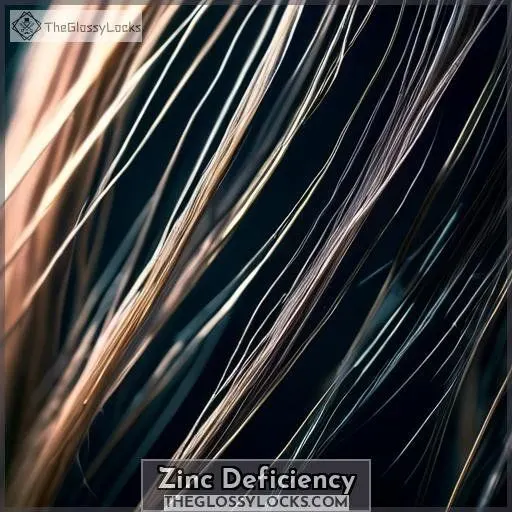This site is supported by our readers. We may earn a commission, at no cost to you, if you purchase through links.

You’re experiencing hair loss as a woman? Nutrient deficiencies could be the culprit.
Iron deficiency reduces hemoglobin production, leading to telogen effluvium.
Insufficient biotin, a B-vitamin, disrupts hair growth.
Low vitamin D levels influence hair follicle cycling, causing premature shedding.
Zinc deficiency interrupts the hair growth cycle, resulting in thinning.
Vitamin E protects hair from oxidative stress.
Don’t overlook these essential nutrients – their roles are pivotal in combating hair loss causes in women.
Unraveling the intricacies behind this issue is key to revitalizing your locks.
Table Of Contents
Key Takeaways
- Iron deficiency can lead to hair loss in women due to reduced hemoglobin production, causing telogen effluvium.
- Biotin deficiency can disrupt hair growth and is often caused by diet, medications, or health conditions.
- Vitamin D deficiency can influence hair follicle cycling, leading to premature shedding and thinning.
- Zinc deficiency can interrupt the hair growth cycle, resulting in thinning.
Iron Deficiency
Iron deficiency can lead to hair loss in women. When your body lacks sufficient iron, it can’t produce hemoglobin, the protein in red blood cells that carries oxygen to your cells, including those responsible for hair growth and repair. This can result in a type of hair loss called telogen effluvium, where widespread thinning occurs due to intense physical stress or illness.
To address iron deficiency-related hair loss, your doctor may recommend iron supplements and dietary modifications to increase your iron intake through iron-rich foods such as red meat, beans, and nuts. It’s crucial to consult with a healthcare professional before taking any supplements to determine the appropriate iron dosage for your needs.
Iron overload, on the other hand, can also lead to hair loss. Excessive iron in the body can accumulate in tissues and organs, affecting their normal function, with the most susceptible organs being the liver, heart, and endocrine glands. Symptoms of iron overload include chronic fatigue, joint pain, abdominal pain, irregular heartbeat, loss of period, lowered libido, skin color changes, and hair loss.
To maintain a balance of iron in your body, avoid consuming excessive amounts of vitamin C, which can enhance iron absorption, and consider drinking tea as the tannin can help inhibit iron absorption. During treatment, you could also benefit from taking a B complex of vitamins, including folic acid, B6 or folate, and B12, all of which are beneficial for hair growth.
Biotin Deficiency
Biotin deficiency is a nutrient deficiency that can lead to hair loss. Biotin, also known as vitamin H, is a B-complex vitamin that plays a vital role in the metabolism of fats, carbohydrates, and proteins. It also aids in the production of fatty acids, which are necessary for hair growth.
Biotin absorption can be impacted by various factors, including diet, medications, and health conditions. For example, consuming raw egg whites can hinder biotin absorption due to a protein called avidin present in them. Certain medications, such as antibiotics and anticonvulsants, can also hinder biotin absorption.
To address biotin deficiency, you can consider taking biotin supplements. The recommended biotin dosage is typically around 30 mcg per day. Biotin sources include foods like egg yolks, almonds, and bananas. Biotin benefits extend beyond hair growth, as it can also promote healthy skin and nails.
If you suspect a biotin deficiency, it’s imperative to consult a healthcare professional. They can assist you in determining the cause and recommending appropriate treatment, which may include biotin supplements or dietary changes. Remember, addressing nutrient deficiencies is essential for maintaining overall health and preventing hair loss.
Vitamin D Deficiency
Vitamin D deficiency can contribute to hair loss, particularly in women. This essential nutrient plays a pivotal role in maintaining healthy hair growth by influencing the hair follicle cycling process. When vitamin D levels are insufficient, the anagen (growth) phase of hair follicles can be shortened, leading to premature entry into the telogen (rest) phase and excessive shedding, resulting in thinner hair.
Research has shown that people with alopecia areata, an autoimmune condition causing patchy hair loss, often have lower vitamin D concentrations than those without the condition. Additionally, vitamin D deficiency may be linked to hair loss in individuals without alopecia areata.
To address vitamin D deficiency, it’s essential to maintain sufficient levels of this nutrient through diet and sun exposure. Foods rich in vitamin D include fatty fish, eggs, chia seeds, some fish like salmon, trout, and sardines, nuts, cheese, and fortified foods. Sunlight exposure is another natural source of vitamin D, but it’s essential to protect your skin from overexposure to avoid skin damage.
If you suspect vitamin D deficiency may be contributing to your hair loss, consult your healthcare provider for a proper diagnosis and treatment recommendations, which may include vitamin D supplements.
Zinc Deficiency
Zinc deficiency can lead to hair loss, as zinc plays a vital role in hair growth and scalp health. It’s involved in immune function and the production of collagen, which is essential for the development of hair follicles. When zinc levels are low, the hair growth cycle can be interrupted, causing shedding and thinning. This can be particularly noticeable in individuals undergoing chemotherapy or experiencing alopecia areata, a condition characterized by patchy hair loss.
To maintain healthy zinc levels, consider including zinc-rich foods in your diet, such as oysters, beef, and pumpkin seeds. However, it’s important not to consume excessive amounts, as too much zinc can be harmful. If you suspect you have zinc deficiency, consult a healthcare professional for personalized advice and treatment options. Remember, a balanced diet and regular check-ups are key to maintaining healthy hair and overall well-being.
Vitamin E Deficiency
Delving into the realm of Vitamin E, it’s the understated champion for your tresses. Envision it as your hair’s stalwart protector, safeguarding it from the relentless assault of oxidative stress that aims to deplete your mane.
In the absence of Vitamin E, telltale signs like thinning hair emerge as warning signals. Ladies, if your tresses are losing their vitality, it’s prudent to assess whether you’re depriving yourself of this crucial nutrient.
The daily regimen to keep your hair radiant includes incorporating sources rich in Vitamin E, such as almonds, spinach, and avocados. However, mere consumption is insufficient; absorption is paramount.
If your hair appears lackluster, a deficiency in Vitamin E may be the underlying cause, particularly in the scenario of androgenetic alopecia in females.
Omega-3 Fatty Acid Deficiency
Omega-3 fatty acids are essential fats that play a vital role in upholding cardiovascular health, brain function, and reducing inflammation. However, regarding hair growth, they’re equally significant. A shortage of omega-3 fatty acids can result in hair loss in women. Here are five ways omega-3 fatty acids contribute to hair health:
- Promote Hair Growth: Omega-3 fatty acids aid in stimulating hair growth by supplying the requisite nutrients for hair follicles to function properly.
- Inflammation Control: Omega-3 fatty acids possess anti-inflammatory properties that can assist in reducing inflammation in the scalp, which can lead to hair loss.
- Hormone Balance: Omega-3 fatty acids can aid in regulating hormones, which can be a contributing factor to hair loss in women.
- Pregnancy and Hair Loss: Pregnancy can cause hormonal changes that result in hair loss. Omega-3 fatty acids can assist in maintaining hormonal balance during pregnancy, reducing the risk of hair loss.
- Hair Cycle and Nutrition: Omega-3 fatty acids play a role in the hair cycle, ensuring that hair grows and sheds properly. Poor nutrition can lead to a deficiency in omega-3 fatty acids, which can contribute to hair thinning.
To guarantee you’re obtaining sufficient omega-3 fatty acids, incorporate foods such as salmon, mackerel, walnuts, and chia seeds into your diet. You can also consider taking a fish oil supplement to augment your intake. By maintaining a balanced diet and addressing any nutrient deficiencies, you can assist in preventing hair loss and promoting healthy hair growth.
Frequently Asked Questions (FAQs)
What are the common causes of hair loss in women?
You’re likely experiencing hormonal shifts, high stress levels, poor nutrition, or an underlying medical issue causing that pesky hair thinning or shedding. Don’t fret, though – there are solutions to regain your luscious locks.
How does hormonal imbalance affect hair loss in women?
Let’s face it, hormones can throw your hair for a loop. Imbalances in estrogen, progesterone, or testosterone can disrupt the hair growth cycle, leading to excessive shedding or thinning. Whether it’s menopause, PCOS, or thyroid issues, getting those hormones in check is key for luscious locks.
Can stress cause hair loss in women?
Absolutely! Stress can take a major toll on your locks. When you’re constantly frazzled, your body goes into survival mode, diverting resources away from non-essential functions like hair growth. So nip stress in the bud to keep those tresses lush.
What role does iron deficiency play in hair loss in women?
Just like a plant deprived of nutrients, your mane can thin when you’re iron deficient. This essential mineral fuels hair follicle growth, so low levels mean those luscious locks may start shedding prematurely. Boost your iron intake through diet or supplements to revive your crowning glory.
How can diet and nutrition impact hair loss in women?
You bet, girl! A nutrient-rich diet full of protein, iron, zinc, and vitamin C can work wonders for luscious locks. Skimping on those goodies starves your follicles, leading to excessive shedding – yikes! Eat up for that runway-ready mane.
Conclusion
Envision luxurious locks flowing effortlessly, a reflection of your body’s harmonious equilibrium.
By targeting nutrient deficiencies that contribute to hair loss in women:
- Iron for hemoglobin
- Biotin for growth
- Vitamin D for follicle cycling
- Zinc for the hair cycle
- Vitamin E against oxidative stress
- Omega-3s for nourishment
You activate nature’s healing potential, paving the way for a rejuvenated mane that exudes vitality from roots to tips.









